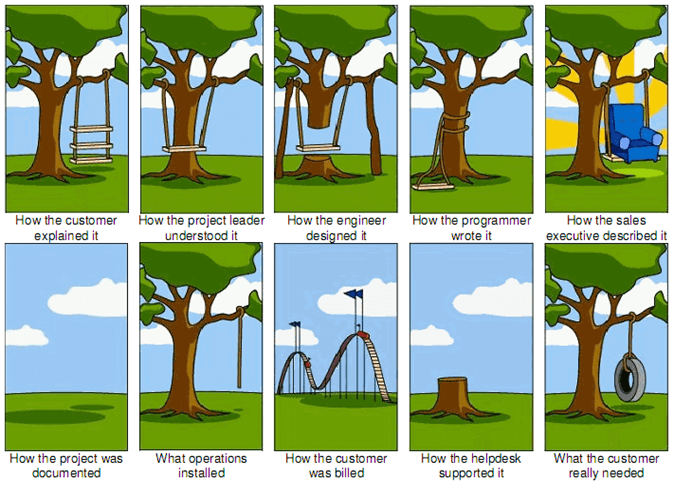1.4 Case Study: The Cost of a Poor Online Presence
No one knows exactly how much poor branding and online communication costs business, industry and government each year, but estimates suggest billions. In fact, a recent estimate claims that the cost in the U.S. for poor communication alone are close to $400 billion annually![1] Poorly-worded or inefficient emails, websites that are misleading, social media posts that go unread due to poor design, hastily presented information, sloppy proofreading — all of these examples result in inevitable costs. The problem is that these costs aren’t usually included on the corporate balance sheet at the end of each year; if they are not properly or clearly defined, the problems remain unsolved.
You may have seen the Project Management Tree Cartoon before (Figure 1.4.1); it has been used and adapted widely to illustrate the perils of poor communication during a project.

The waste caused by imprecisely worded website headers, confusing emails, posts that don’t add value, ambiguously written contracts, and other examples of poor communication is not as easily identified as the losses caused by a bridge collapse or a flood. But the losses are just as real: measured in wasted time, work, money, and ultimately, business.
The following “case study” shows how a poor online presence can have real world costs and consequences. For example, consider Google+, which launched in 2011, following Facebook’s prolific adoption. The site shut-down on April 2, 2019.
“Given the challenges in creating and maintaining a successful Google+ that meets our consumer users’ expectations, we decided to sunset the consumer version of Google+. We’re committed to focusing on our enterprise efforts, and will be launching new features purpose-built for businesses. Read the announcement.” (Google. 2022)[3].
Even before a data-breach of over 500,000 Google+ users’ data was exposed by the Wall Street Journal,[4] the platform was slated to be shut-down. A lack of engagement was at the heart of the decision. People did not tend to spend more than 5 seconds at a time on the social media app. While Google+ tried new layouts, it never really met the needs of its users, 73.3% of which identified as male[5]. Furthermore, 90% of users never posted anything on the platform. Without a “feed” or news-reel, the app did nothing help people connect and bring stories to life.
The issue was mainly the presence of the site was ambiguous. There was no clear communication strategy: No purpose or reason why people should interact in the space. At the time of shut-down, Google+ lost over 111 million users.
- J. Bernoff, "Bad writing costs business billions," Daily Beast, Apr. 23, 2017 [Online]. Available: https://www.thedailybeast.com/bad-writing-costs-businesses-billions?ref=scroll ↵
- J. Ward, "The project management tree swing cartoon, past and present," TamingData, July 8, 2019 ↵
- Google. (2022). Frequently asked questions about the Google+ shutdown. https://support.google.com/googlecurrents/answer/9217723 ↵
- MacMillian, D. & McMillan, R. (2022, October 8). Google Exposed User Data, Feared Repercussions of Disclosing to Public. https://www.wsj.com/articles/google-exposed-user-data-feared-repercussions-of-disclosing-to-public-1539017194 ↵
- Kasteler, J. (2016, May 30). Facts & Stats To Help You Determine If Your Business Should Use Google+. https://www.searchenginepeople.com/blog/16051-google-plus-stats.html ↵

